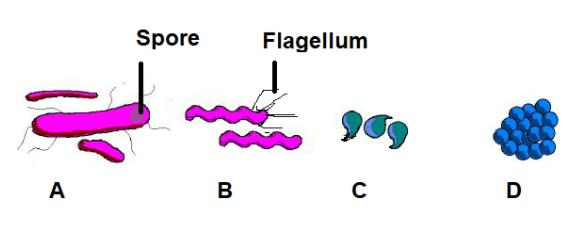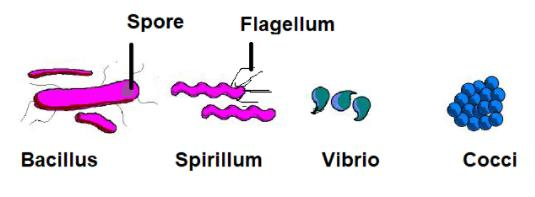
Bacteria are grouped under four categories according to their shape. Study the given figures and select the correct option regarding this.

A) A. Cocci B. Bacilli C. Spirilla D. Vibrio
B) A. Spirilla B. Bacilli C. Vibrio D. Cocci
C) A. Bacilli B. Spirilla C. Vibrio D. Cocci
D) A. Bacilli B. Spirilla C. Cocci D. Vibrio

Answer
424.2k+ views
Hint: Bacteria re the small unicellular organisms which are present everywhere on the Earth. The bacteria are both found in solitary as well as in clusters. They can tolerate extreme conditions of temperature and pressure. They exist in various shapes mostly spherical or rod like.
Complete answer:
To answer this question, we must know the classification of bacteria depending on the structure.
The bacterial cell is about the 0ne- tenth in size of the eukaryotic cell. They can only be visible under a microscope. They mostly exist in spherical and rod shapes but various other shapes can also be seen. The variety of shapes is determined by the cell wall and the cytoskeleton. The significance of this shape is it helps the bacterium to absorb nutrients, attach to the surfaces and also swim across the fluid so as to escape the predators.
The four important shapes of bacteria are-
Rod shaped or bacillus- Bacillus means to stick like. They are rod shaped and are the most commonly type of bacterium found. This shape helps the bacteria to concentrate proteins in specific regions. This bacterium forms spores which make them inert/ inactive in an extreme environment. Example Bacillus subtilis. Figure A represents the Bacilli form.
Spiral shaped or spirilla- It is the third major category of the bacterium. They are identified by their motility, twists in the cell as well as flexibility. They mostly have flagella for locomotion. Example-Helicobacter. The image B represents Spirilla.
Comma shaped or Vibrio- There are curved-rod or comma shaped bacteria. They are gram negative and do not form spores. The species of this genus are motile. Example Vibrio cholerae which causes cholera in humans. The figure C represents Vibrio.
Spherical shaped or cocci- The cocci are the spherical shaped bacterium. It resembles grain or seed. They can be found in clusters or singly. An example of cocci is streptococcus which resembles a bunch of grapes. The figure D given in the question is Cocci.

Thus the correct answer is option ‘C’.
Note: The bacterial cell is enclosed within a thin cell wall which is responsible for the characteristic shape of the bacterial cells. As bacterium is a prokaryotic organism, it lacks all the membrane bound organelles including the nucleus. They have flagella, fimbriae for locomotion.
Complete answer:
To answer this question, we must know the classification of bacteria depending on the structure.
The bacterial cell is about the 0ne- tenth in size of the eukaryotic cell. They can only be visible under a microscope. They mostly exist in spherical and rod shapes but various other shapes can also be seen. The variety of shapes is determined by the cell wall and the cytoskeleton. The significance of this shape is it helps the bacterium to absorb nutrients, attach to the surfaces and also swim across the fluid so as to escape the predators.
The four important shapes of bacteria are-
Rod shaped or bacillus- Bacillus means to stick like. They are rod shaped and are the most commonly type of bacterium found. This shape helps the bacteria to concentrate proteins in specific regions. This bacterium forms spores which make them inert/ inactive in an extreme environment. Example Bacillus subtilis. Figure A represents the Bacilli form.
Spiral shaped or spirilla- It is the third major category of the bacterium. They are identified by their motility, twists in the cell as well as flexibility. They mostly have flagella for locomotion. Example-Helicobacter. The image B represents Spirilla.
Comma shaped or Vibrio- There are curved-rod or comma shaped bacteria. They are gram negative and do not form spores. The species of this genus are motile. Example Vibrio cholerae which causes cholera in humans. The figure C represents Vibrio.
Spherical shaped or cocci- The cocci are the spherical shaped bacterium. It resembles grain or seed. They can be found in clusters or singly. An example of cocci is streptococcus which resembles a bunch of grapes. The figure D given in the question is Cocci.

Thus the correct answer is option ‘C’.
Note: The bacterial cell is enclosed within a thin cell wall which is responsible for the characteristic shape of the bacterial cells. As bacterium is a prokaryotic organism, it lacks all the membrane bound organelles including the nucleus. They have flagella, fimbriae for locomotion.
Recently Updated Pages
Master Class 11 Economics: Engaging Questions & Answers for Success

Master Class 11 Business Studies: Engaging Questions & Answers for Success

Master Class 11 Accountancy: Engaging Questions & Answers for Success

Master Class 11 English: Engaging Questions & Answers for Success

Master Class 11 Computer Science: Engaging Questions & Answers for Success

Master Class 11 Maths: Engaging Questions & Answers for Success

Trending doubts
Which one is a true fish A Jellyfish B Starfish C Dogfish class 11 biology CBSE

State and prove Bernoullis theorem class 11 physics CBSE

1 ton equals to A 100 kg B 1000 kg C 10 kg D 10000 class 11 physics CBSE

In which part of the body the blood is purified oxygenation class 11 biology CBSE

One Metric ton is equal to kg A 10000 B 1000 C 100 class 11 physics CBSE

Difference Between Prokaryotic Cells and Eukaryotic Cells




